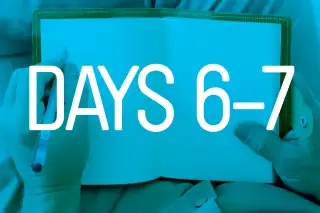Why You Should Track Your Spending Over the Weekend (and Beyond)

This is the Day 6 & 7 challenge in the #Money30, a month-long bootcamp for personal finance novices. You can read mor about the challenge here, and follow along with us on Twitter, Instagram, or email us at feedback@moneymail.com.
TIME BUDGET: 30 MINUTES
If you’ve been keeping up with our 30-Day Money Challenge, then you’ve already started building good money habits like learning how to read your pay stub and checking your credit report.
But it’s virtually impossible to budget – or save – if you aren't paying any attention to the in-flows and out-flows of your money. According to a 2016 Bankrate survey, nearly a quarter of Americans say they save nothing at all—which is not surprising given that an earlier Bankrate survey found that 38% of Americans don’t track their spending against a budget.
Tracking your spending is one of the most important things you can do to get yourself on the right financial path, says Chantel Bonneau, a financial adviser at Northwestern Mutual. “If you don’t know what you’re working with, it’s harder to make proactive decisions about your money.”
So here's your next challenge: Over the weekend, take about 30 minutes to sit down and outline exactly where your money is going.
Here are three basic steps that will get you started.
1) Pick your tracking tool
Dozens of money-tracking apps can help you master and manage the flow of your money. Mint, for example, links to your credit card and bank accounts and buckets your spending into intuitive categories. Other personal finance apps, including GoodBudget, Mvelopes, BillGuard, Pocket Expense, offer a range bells and whistles, but ultimately get at the same thing: helping you get a handle on your finances.
Bonneau says that the simpler the app you’re using, the better. “If you’re going to use an app and it’s overwhelming, it’s not for you.”
If using an app linked to your bank account makes you nervous for security reasons, you can often work directly though your bank—Wells Fargo, for example, offers customers a personal spending report that tracks monthly spending, budget goals, and averages over time.
Finally, don’t underestimate the old-fashioned approach: a basic spreadsheet or even paper and pencil. Some experts argue that budgeting by hand can, neurologically speaking, be a more effective way to create positive habits.
Money’s “How much am I spending” calculator: How much am I spending?
2) Take small bites
Whatever tracking method you choose, Bonneau recommends tackling small tasks first. Outline your fixed expenses like rent and car payments. After you’ve analyzed those, address your discretionary spending.
For example, choose one spending category, like clothing expenses, to track. Once you know how much you typically spend in a discretionary category, you can compare that to how much you’re spending on fixed costs and adjust accordingly.
3) Set long-term goals.
Once you’ve identified what you’re spending on, you can prioritize your spending. For example, should you be spending $100 on brunch a month when you could cook at home and put that money towards a long-term goal?
And if you’re still having trouble saving, try reevaluating your spending goals and automating your savings.
—Alexandra Mondalek
Have a question, comment, or suggestion? Email us at feedback@moneymail.com.